Looking to the future of space exploration, NASA’s priorities are sometimes subject to change. In 2004, the Bush administration released it’s “Vision for Space Exploration“, which called for the development of rockets that would return astronauts to the Moon. This policy was later replaced by the NASA Authorization Act of 2010, which outlined plans to send humans to an asteroid by 2025 and to Mars in the 2030s.
Earlier today, on Thursday, October 5th, Vice President Mike Pence and several members of the Trump administration announced that their priorities have shifted once again. Instead of proceeding with NASA’s proposed “Journey to Mars“, the administration has set its sights on once again mounting crewed missions to the Moon and establishing a permanent presence on the lunar surface.
The announcement came during the inaugural meeting of the National Space Council, the newly-reestablished executive group that will be guiding US space policy in the coming years. Originally established in 1989 by then-president George H.W. Bush (and disbanded in 1993 by the Clinton administration), this council served the same purpose as the National Aeronautics and Space Council – which oversaw space policy between 1958 and 1973.
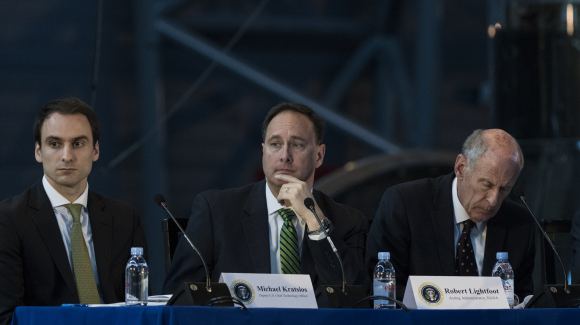
The meeting, titled “Leading the Next Frontier: An Event with the National Space Council“, took place at the Smithsonian National Air and Space Museum’s (NASM) Steven F. Udvar-Hazy Center in Chantilly, Virginia. The meeting was chaired by Vice President Mike Pence with the participation of NASA Administrator Robert Lightfoot, and was attended by Trump Administration cabinet members, senior officials, and aerospace industry leaders.
During the course of the meeting, which was live-streamed, Vice President Mike Pence laid out the administration’s plans for returning astronauts to the Moon. Emphasizing the need to restore NASA and America’s leadership in space, Pence compared the current situation to the early years of the Space Race and the crowing achievement that was the Apollo 11 mission. As he said:
“It is altogether fitting that we chose this week for the first meeting of the National Space Council. Yesterday marked the 60th anniversary of Sputnik, that 184-pound satellite that changed the course of history. On that day, six decades ago yesterday, the race for space began and the then-Soviet Union took an early lead. But the sight of that light blinking across that October sky spurred America to action. We refused to accept a future in space written by the enemies of freedom, and so the United States of America vowed to claim our rightful place as the undisputed leader in the exploration of the heavens. And twelve years later, with “one giant leap for mankind”, America led in space.
Moving to the present, Pence indicated that the reestablishment of he National Space Council would put an end to the ways in which space exploration has stalled in recent decades. He also indicated how a return to the Moon – a goal which diminished in important in the post-Apollo era – would recapture the spirit of the past and reinvigorate modern space exploration.
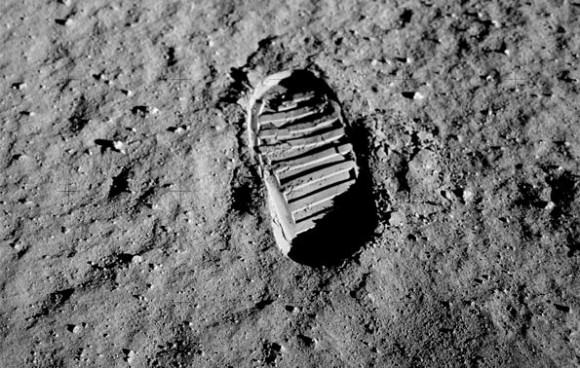
As he expressed during the course of the meeting, the way space exploration has stalled is in part due to the way in which the Moon (as a destination) has diminished in importance:
“Our struggle to define the direction and purpose of America’s space program dates back decades to the post-Apollo period. We had just won the race to the Moon and suddenly the question became, ‘What should we do? Where should we go next?’ In the debate that followed, sending Americans to the Moon was treated as a triumph to be remembered, but not repeated. Every passing year that the Moon remained squarely in the rear-view mirror further eroded our ability to return to the lunar domain and made it more likely that we would forget why we ever wanted to go in the first place.”
A renewed mission to the Moon, claimed Pence, will put an end to decades in which not a single NASA astronaut has ventured beyond Low Earth Orbit. He further indicated how after the retirement of the Space Shuttle Program, the US has been dependent on Russia to ferry astronauts to the International Space Station. He also voiced criticism for the Obama administration, claiming that it chose “capitulation” when it came to the space race.
While this new policy technically represents a break from the policy of the Obama administration, and a return to the policy of the Bush administration, Pence emphasized that returning to the Moon would be a stepping stone towards an eventual crewed mission to the Red Planet. This announcement also put an end to months of ambiguity regarding the Trump administration’s space policy.
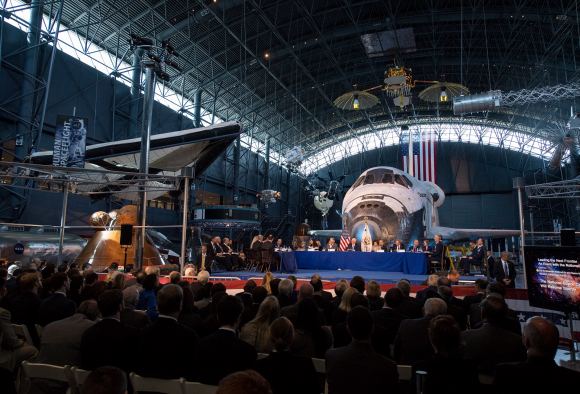
In the past, VP Pence has spoken about the need to return to the Moon and puts boots on Mars, but nothing definitive was said. This ambiguity, it is worth noting, has also been a source of anxiety for those at NASA, who were unsure about the future budget environment. And while this meeting did indicate that the Trump administration has a policy, many aspects of it were already in place before the administration took office.
After the meeting concluded, acting NASA Administrator Robert Lightfoot spoke of the results in a NASA press statement. In reference to the direction VP Pence had indicated for the agency, he said the following:
“Specifically, NASA has been directed to develop a plan for an innovative and sustainable program of exploration with commercial and international partners to enable human expansion across the solar system, returning humans to the Moon for long-term exploration and utilization, followed by human missions to Mars and other destinations.”
Much of the details discussed at the meeting were already established as early as last September. It was at this time that the NASA Transition Authorization Act of 2016, a provisional measure that guaranteed short-term stability for the agency by allocating $19.5 billion in funding for NASA for fiscal year 2017. Intrinsic to the Act was the cancellation for the NASA’s Asteroid Robotic Redirect Missions (ARRM) in favor of a more cost-effective alternative.
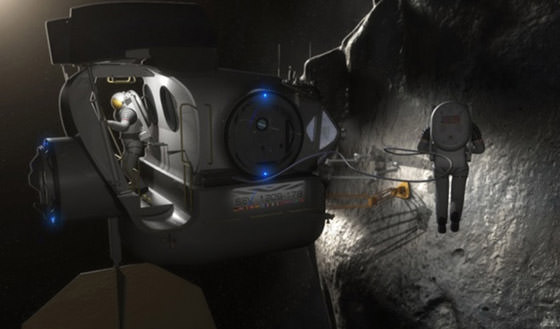
As Lightfoot indicated, this would still be the case under the current administration’s plan:
“The recommendation to the president would modify the existing National Space Policy to provide focus and direction to some of NASA’s current activities and plans, and remove a previous guideline that NASA should undertake a human mission to an asteroid as the next human spaceflight milestone beyond low-Earth orbit.”
Lighfoot also reiterated what Pence said during the meeting, how renewed missions to the Moon would ultimately assist NASA’s efforts to mount crewed missions to Mars. These included the importance of cis-lunar space to the exploration of both the Moon and the Mars, as well as its use as a proving ground for future mission to Mars and beyond in the Solar System.
“Based on a number of conversations I’ve had with the council,” he said, “we have highlighted a number of initiatives underway in this important area, including a study of an orbital gateway or outpost that could support a sustained cadence of robotic and human missions, as well as ensuing human missions to the lunar and Mars surfaces, and other destinations.”
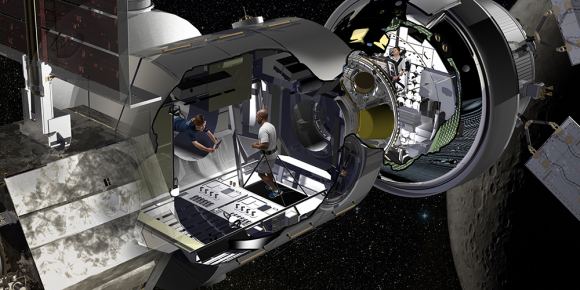
While this latest announcement does confirm what many have suspected for some time – that the Trump administration would prioritize lunar exploration – much ambiguity remains. While Pence emphasized that the re-establishment of the NSC was intrinsic to restoring American leadership in space, very little appears to have changed since the NASA Transition Authorization Act of 2016.
What’s more, despite Pence’s claims of “capitulation” on behalf of the Obama administration, much of the current administration’s policy represents a continuation of the NASA Authorization Act of 2010. These include the use of the Space Launch System (SLS), the Orion spacecraft, and the restoration of domestic launch capability. In short, much of the Trump administration’s plans to restore American leadership in space are piggybacking on the accomplishments of the Obama administration.
Beyond that, the creation of the Deep Space Gateway appears unaffected, since its existence is central to both renewed mission to the Moon and for crewed missions to Mars. And the long-term plan for the exploration of Mars appear to still be intact. So in many ways, this latest announcement is not much in the way of news, but also good news.
When it comes to organizations like NASA and space exploration in general, continuity is not only preferable, but necessary. And in the meantime, be sure to check out the live coverage of the event:

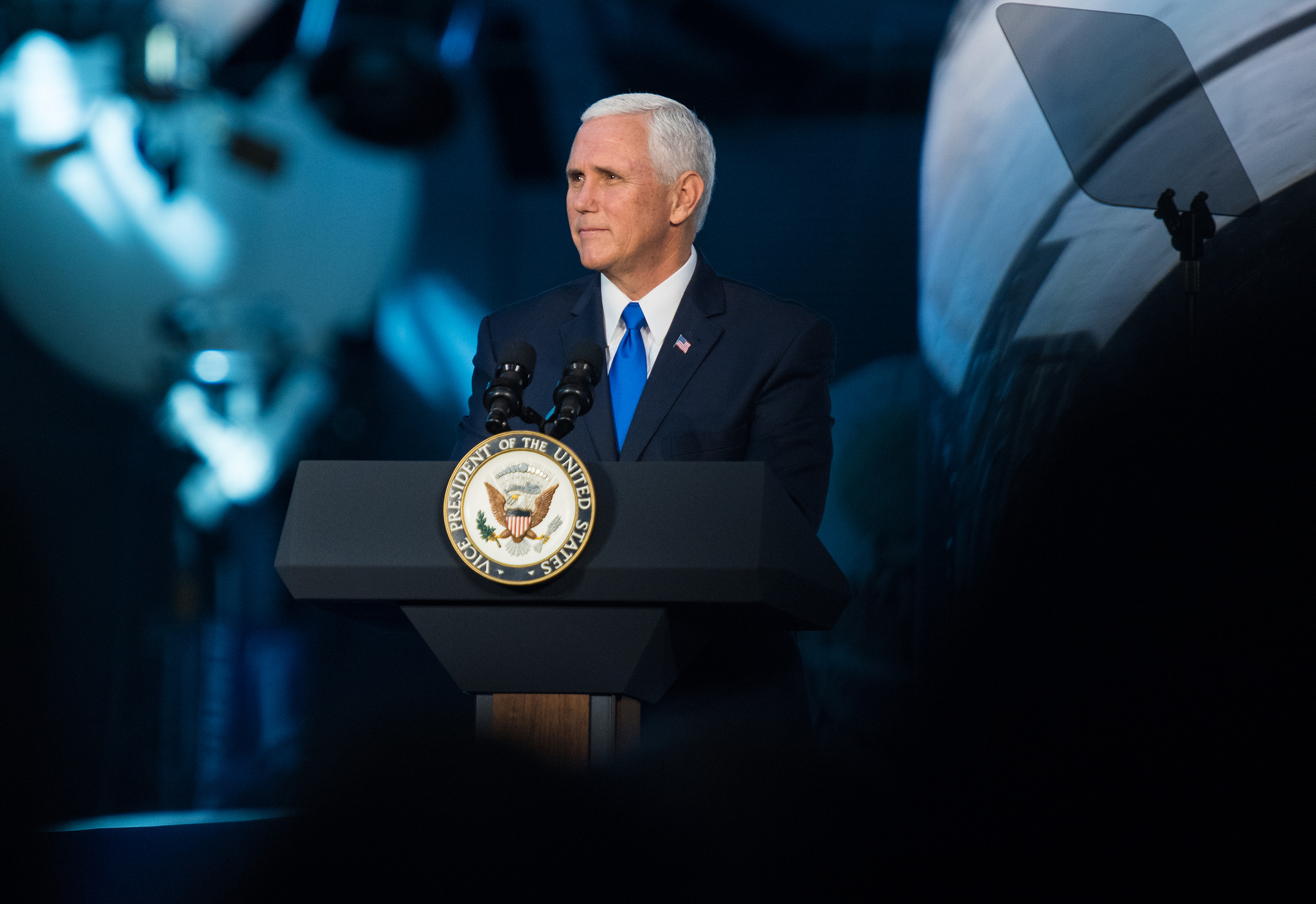
While I’m in no way a Mike Pence fan, I do think the overall quality information in this article is neutralized by the overarching attempt to subtlety critique the Trump administration.
In reality, making the Moon our top priority once again is THE only thing that makes logical sense. I’ve long been dismayed as to why NASA (and the Obama administration) wanted to go straight to Mars, and not only go there, but attempt a manned landing on Phobos or Deimos first.
I’m sorry, but that was absolutely idiotic. If we truly haven’t been back to the Moon in over 40 years- and the majority of data on radiation, etc affecting the Apollo astronauts has truly been “lost”- then we need to re-learn manned exploration in this safer environment closer to home.
If something goes wrong on the lunar surface, you can theoretically have a rescue mission there in 4-5 days. If something goes wrong on Mars, help is at least 4 MONTHS away, and the crew is dead.
We should not underestimate the importance of re-establishing the Moon as our top priority. The previous administration DID capitulate, in that it agreed to not have a clear ultimate goal, and not have set deadlines in place for completion of it.
My only hope is that Pence follows up this re-direction with actual timelines and specifics to making it happen. Reaching the Moon first not only restores a more logical progression to man’s return to manned exploration, but hopefully will re-affirm beliefs in people like me who are really starting to wonder if we even got there in the first place.
Jim, nothing contained within this article was less than factual. The Trump administration has been mute on its plans for space exploration until now. And its current plan depends heavily on infrastructure initiated by the Obama administration, which Pence’s speech failed to note. He also incorrectly attacked the previous administration for “capitulating” leadership in space in what was a blatant at of partisanship.
OK, interesting. I hadn’t realized that the USA is leading from behind in space. I thought we had been relying on Russian rockets.
The US is still leading in space. Since 2011, it has not had domestic launch capability. But with the development of the SLS and the Orion, not to mention the Falcon Heavy and the New Glenn, that’s changing.
What’s more, the Journey to Mars was not idiotic at all. It called for the creation of infrastructure that would allow for missions to Mars, and facilitate return trips to the Moon. It is for this very reason that neither the Trump admin or the NSC is cancelling things like the Deep Space Gateway, the SLS, the Orion capsule, or the Mars Base Camp. They still intend to do these things, just mount manned mission to the Moon before that.
Matt, everyone who has taken the time to comment here has pointed out your partisanship, so I am not alone in that regard.
Going to Mars itself is not idiotic; hopefully we do it some day.
Going to Mars WITHOUT first re-figuring out how to safely land on the Moon, AND wanting to first land on Phobos or Deimos BEFORE Mars- which unlike Mars, would have no protective atmosphere, and an irregular gravity field- was absolutely and undeniably idiotic.
Very little about the Obama administration was criticized by the mainstream media over the past 8 years. His Mars plan is one area where Universe Today should’ve objectively stepped up, and leveled fair critique for the reckless lack of building blocks leading up to it.
Everyone? I count you and one other person, who also seems to think everyone agrees with him. In reality, everyone else was focused on the actual policy and leaving accusations of bias out of it. So please don’t falsely claim you speak for everyone. And whether or not people are alone in pointing that out is irrelevant. The reality of this speech was that IT was heavy on partisanship and light on facts, which I felt obliged to point out.
What’s more, the plan that was announced, while initially eloquent, came down to little more than re-establishing a Bush-era priority after months of having no policy in place and the reactivation of the NSC. And Pence falsely spoke as if this and this alone was the first effort to reverse decades of inaction, which is untrue. Nothing I said was less than factual so accusing me of personal bias seems rather personal on your part.
Also, my criticism has nothing to do with the goals, it has to do with the lack of planning and the misrepresentation of facts. So bringing up a “lack of criticism of Obama’s plan” is also irrelevant and an obvious deflection. Also, it was not Obama’s plan. The Mars Direct plan was something NASA has been talking about since the 1990s, which the Obama administration signed off on. And last, every aspect of the “Journey to Mars” was planned out in detail, from the development of the SLS and the Orion Capsule, the development of the Deep Space Gateway and Transport, to the development of the Mars Base Camp and the Lander. And since NASA was already involved in the joint development of lunar base with the ESA and Roscosmos during the Obama administration, claiming they were ignoring the Moon with their Mars Direct plan is just plain false. NASA is already planning on developing the Moon, but they were looking further.
Universe Today covered all of these developments and plans and assessed their risks and payoffs. So your claim that building blocks were missing or that we didn’t cover it objectively is patently false. As I’ve told people who’ve written to me to complain about calling Pluto a “dwarf planet”, I am under no obligation to represent or satisfy your opinions. We can agree to disagree, but let’s not make false or petty accusations. That is beneath us.
Matt, what you perhaps should have done is write two separate articles: one objectively covering the change in policy, and a separate one for your critiques about it.
Again, you were incapable of keeping the two separated, leading to a very biased article.
Like it or not, space exploration under the Obama administration had no specific timeline. The Constellation program was axed, costing billions, and a very similar SLS system was put in its place. Time frames for returning to space continued to be pushed back again and again, and after selling the public on “returning to the Moon”, NASA quietly dropped that goal without any explanation, despite landing on an asteroid moon being far more high risk.
It is vital that we return to the Moon first, and I find it refreshing that the new administration realizes that as well.
Back to Plan A, is the correct decision. The “Journey to Mars” was a “Bridge too Far”.
High risk undertakings are more suitable for people like Elon Musk than for NASA.
I agree with the other comments; this is the right move by the administration. It’s too bad Matt can’t leave his ultra liberal views off the page and just report the pertinent science news. Including his bias against the current administration in his article is unprofessional.
This is the pertinent science news, Ken. The reality is that the plan to return to the Moon would utilize infrastructure creating during the Obama administration. It is also a reality that partisan rhetoric intruded on the facts during Pence’s speech. Perhaps you should check your own bias, and not fault others for being “unprofessional” because they don’t share it.
Matt, what you perhaps should have done is write two separate articles: one objectively covering the change in policy, and a separate one for your critiques about it.
Again, you were incapable of keeping the two separated, leading to a very biased article.
Like it or not, space exploration under the Obama administration had no specific timeline. The Constellation program was axed, costing billions, and a very similar SLS system was put in its place. Time frames for returning to space continued to be pushed back again and again, and after selling the public on “returning to the Moon”, NASA quietly dropped that goal without any explanation, despite landing on an asteroid moon being far more high risk.
It is vital that we return to the Moon first, and I find it refreshing that the new administration realizes that as well.
First time on this website and I see a picture credited as Apollo 11 image of flag planting………with a Lunar Rover?!? Credibility gone
I’m a liberal Democrat, and there are very few positive things I can say about the Trump administration generally, or Mike Pence individually. However, I always felt that going to Mars while ignoring the Moon was a mistake. I am very supportive of this approach, particularly with reference to Pence’s statement about “long-term exploration and utilization” of the Moon. Long-term habitation of a lunar base would give us a great deal of experience that we could use when we go to Mars (although there are certainly a number of very significant differences between Mars and the Moon in this regard, not the least of which are the two-week-long nights on the Moon.)
I share Matt’s dismay of the word “capitulation,” particularly in view of the fact that the U.S. is currently working on three separate manned spacecraft, more than any nation on Earth has had at one time in history. It is also relevant to note that the Trump administration intends to utilize the infrastructure created by the Obama administration to achieve its goals.
Fundamentally, though, the main thing is what will be accomplished. If this policy change actually gets us to the Moon (meaning, among other things, that it will get adequate funding, something missing under the Dubya administration’s Constellation program), then I will be happy, and I will thank the people who caused it to happen, whatever their political affiliation.
OTOH, two years into the Obama Administration, the last Space Shuttle flew. Six years later, we’re still dependent on Russia. {crippled}
A new administration = a new meaningless manned space policy. There is no reason to go to the Mars, or the Moon either. There is absolutely nothing worthwhile to do on either place. As happened in the 70s, and as has already happened with the space station, the American public would quickly lose interest. But it really doesn’t matter, because it’s not going to happen.
The triumphs of Apollo were one of the highlights of my life. But that was then. Further manned space exploration simply makes no sense.
Although I’m not opposed to returning to the moon, the justification seems lacking. “Emphasizing the need to restore NASA and America’s leadership in space…” This is ridiculous. Who is ahead of the US in space travel? We have amazing probes operating all over the solar system, including several amazing rovers on Mars. SpaceX alone is launching more payloads into orbit than any other single country this year. I don’t see how we are trailing anyone in space flight.
Well, from a species survival standpoint, reaching the Moon is vital. Although humans have colonized every niche on Earth, from a cosmic perspective, we are only occupying one “niche” in the Cosmos.
And we have seen countless times what happens to organisms here on the Earth who only occupy a limited niche, and then that niche is disrupted.
It is implicit for advanced civilizations to colonize other worlds, to increase their chances of long-term survivability.